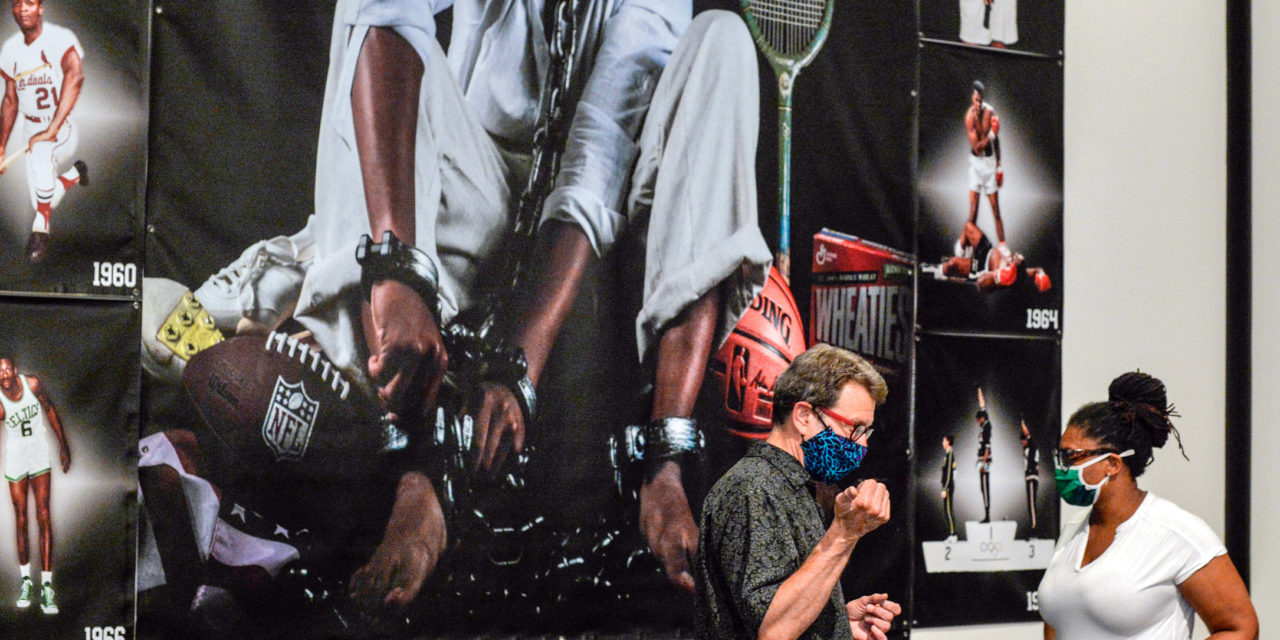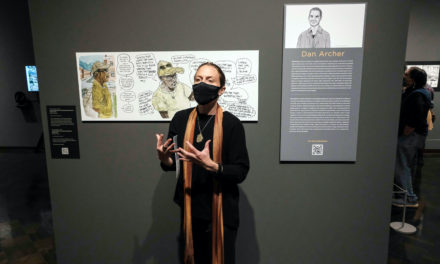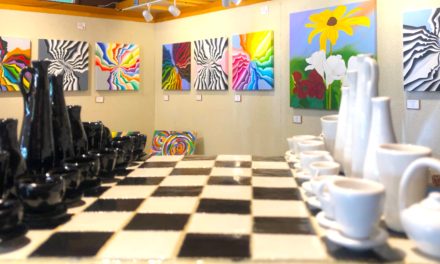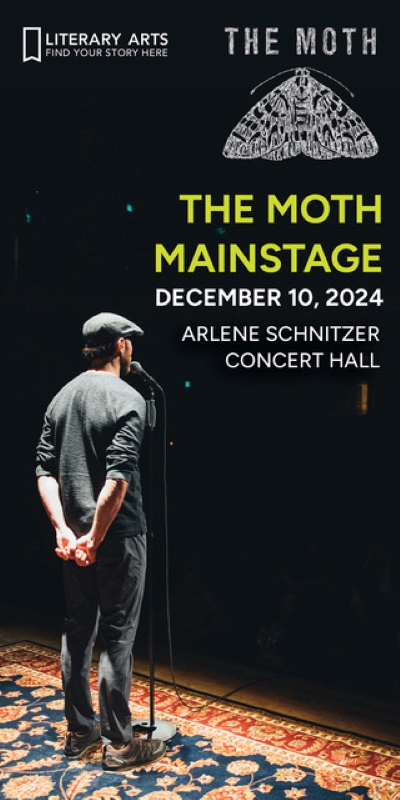(Above: John Weber, executive director of the University of Oregon’s Jordan Schnitzer Museum of Art and Aris Hall, coordinator of the UO’s Lyllye Reynolds-Parker Black Cultural Center, stand in front of a large installation that traces the rise of activism among minority athletes since the mid-20th century. Both Weber and Hall served on the five-member panel that selected the 20 artworks that make up the UO’s Black Lives Matter exhibit, which will be on display through Nov. 21. Photos by Paul Carter.)
By Randi Bjornstad
A powerful exhibit has opened at the University of Oregon’s Jordan Schnitzer Museum of Art, revealing individual Oregon artists’ interpretations of the Black Lives Matter movement that sprang to life immediately after the murder in Minneapolis of George Floyd at the hands of police.
The 20 pieces in the new UO show have a wide range of approaches — among them painting, sculpture, photography, video, and installation —all funded by the Jordan Schnitzer Family Foundation in the form of of competitive grants, each in the amount of $2,500.
The foundation also made equal grants to to the same number of artists in the geographic areas of Portland State University and Washington State University, which also have relationships with the Schnitzer foundation. The UO museum grants include work by Oregon artists outside the Portland area.
“There were 260 applications for the three projects, and in one case here two people applied jointly for one project, so we had 21 artists where the other areas had 20,” UO art museum spokeswoman Debbie Williamson Smith said. “From this region, we had artists from Eugene, Bend, Creswell, Veneta, and Ashland apply.”
The artists with work in the Eugene exhibit are John Adair, Mika Aono, Gabriel Barrera, Gabby Beauvais, the team of Kathleen Caprario and Gregory Stanley Black, Marco Elliott, Marina Hajek, Jasmine Jackson, Mya Lansing, Ana-Maurine Lara, Anthony Adonis Lewis, Malik Lavette, Naomi Meyer, Michael Moloi, Artemas Quazar Ori, Michael Perkins, Josh Sands, Aaron Thompson, Stormie True, and MO WO.

In BLK&GLD, rips in the portraits of artist John Adair’s family members represent the number of times each has been subjected to racism.
The results are as varied as the personal experiences of the artists, ranging from a gigantic photographic mural tracing the rise of activism in the athletic community through the past half-century to a series of black-and-white photographs of the artist John Adair’s family members, torn into segments that represent the number of times each person recounted an experience of racism and “repaired” with gold leaf, which the artist describes as “a Japanese art practice of mending pottery with gold leaf to signal its history and increase its beauty.”
Another entry depicts side-by-side grocery shelves. One side is laden with foods characteristic of a “food desert,” commonly found in predominantly poor, often minority communities, with few fresh fruits and vegetables and more highly processed and high-sugar foods. The other side depicts a “food oasis,” filled with a much greater variety of healthful food choices commonly available in wealthier, often majority white communities.
Several videos are included in the exhibit, as well as a sumptuously created wall hanging of vividly colored felt cut with pinking shears and layered to create profile portraits of black people.
Another series, created by Marina Hajek, a Eugene artist originally from Guatemala, features three-dimensional portraits of recycled paper and ink on particle wood with descriptions and quotations written across them. One ends with a quotation from farmworker and union organizer Cesar Chavez: “If you really want to make a friend, go to someone’s house and eat with him …. the people who give you their food give you their heart.”

One of the bas-relief portraits by Marina Hajek, titled Eloisa Y Pedro.
The jury that evaluated applications for the UO’s exhibit included John Weber, executive director of the Jordan Schnitzer Museum of Art; Aris Hall, coordinator of the UO’s Lyllye Reynolds-Parker Black Cultural Center; Sabrina Madison-Cannon, professor of dance and Phyllis and Andrew Berwick dean in the UO School of Music and Dance; Jamar Bean, program director of the UO’s Multicultural Center; and Jovencio de la Paz, assistant professor of art at the UO.
Hall said she was impressed “with the seamlessness of how this exhibit came together.”
“We all are not artists personally, but we wanted to make sure that what was being expressed in this show was more than just the moment,” she said. “We wanted to let the ideas and the artistry of these people really shine through.”
Many of the artists included in the exhibit “have never been in a museum show before,” Weber said, “but this work includes a lot of contrast in emotional and psychological approaches. These artists have looked at Black Lives Matter in different ways, some through history, some through experience, some through societal separation on racial issues.”
The result is an amazing variety of ages, issues, and mediums. Notably, applicants were not asked to divulge their racial or cultural backgrounds. Instead, the artists were asked to describe their personal relationship to the Black Lives Matter issues and movement, Weber said.
“These artists are not all Black — we wanted to choose who and what would be in this show by their expressing how this point in time that has raised all these issues and emotions relates to them personally,” Hall said. “As a result, we have a combination of new artists and seasoned artists and a show that is about art but also much more than art. I am amazed at the myriad of artistry that these people have brought to it.”
At the same time, because the artists have gone to such lengths to plumb their own beliefs and reactions in creating their art — and also to express them in artist statements that accompany their work — visitors will have another way to help evaluate their own ideas and responses, Weber said.
“It’s particularly important that we have these artists’ voices and their words — and what is on these walls with their art is their own words,” he said. “This is in no way a knee-jerk protest art show — this is a deeper interpretation of powerful issues and emotions.”
Jordan Schnitzer Museum of Art presents the Black Lives Matter Exhibit
When: Through Nov. 21; public outdoor opening reception from 5 p.m. to 7 p.m. on Thursday, July 8
Where: Jordan Schnitzer Museum of Art, 1430 Johnson Lane on the University of Oregon campus
Public hours during pandemic: 11 a.m. to 5 p.m. Saturday and Sunday
Academic hours during pandemic:
- Monday through Thursday — Academic visits by appointment
- Friday — 11 a.m. to 5 p.m. (University of Oregon faculty, staff, students and JSMA members only)
Information: 541-346-3027 or jsma.uoregon.edu
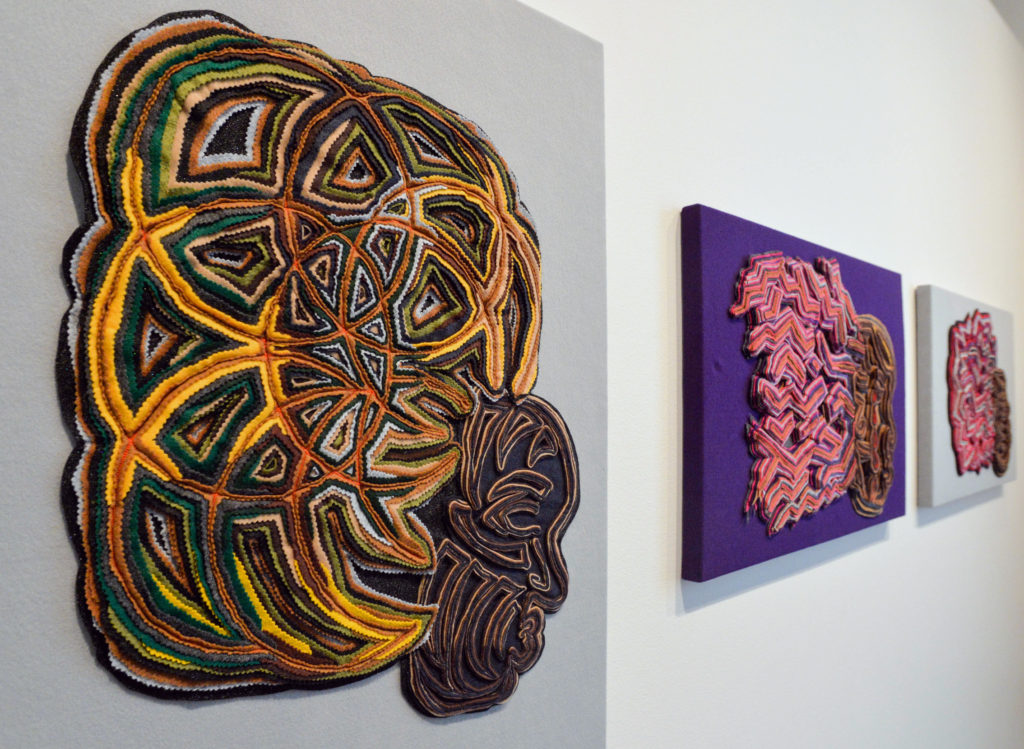
Stormie True’s layered felt portraits, Survivalist Perspective

